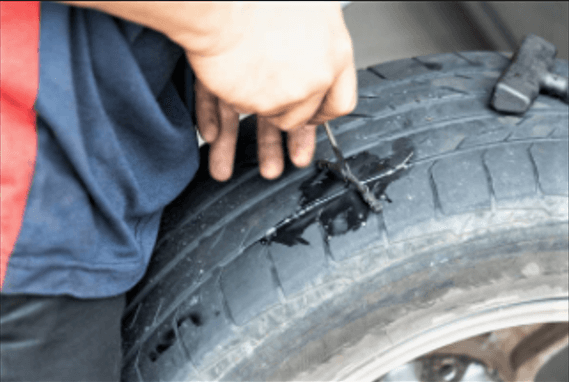When tires are punctured, which may be due to running over a nail, screw, or other sharp objects, such tires should be fixed if not replaced outright.
So in, this guide will walk you through all you need to fix a punctured tire using a plug kit. Most importantly, we will clear your everyday doubt about fixing a punctured tire with the aid of a plug kit with as many details as necessary, especially on how long the rubber cement should be allowed to dry. And all the tools you’ll need to apply rubber cement and substitute tools or materials found in different tire repair toolkits.
Table of Contents
How To Plug Tires With Plug Kit
Fixing a tire for the first time might be a hassling experience since you’re not skilled. Not knowing the dos and don’ts of using a plug kit might leave you stuck on the road in a case where you need to do an emergency fix to get to your destination.
Let me walk you through all the materials and tools needed to plug a punctured tire with rubber cement.
1). Get Your Toolkit:
The first step is to get your tire repair toolkit ready, so we can be at par and in unison to get your punctured tire fixed.
You can easily order your repair toolkit from online stores like Amazon. I believe that no matter the type of toolkit in your possession, you should still find this guide very handy for a well-done job.
2). Locate The Punctured Part:
The first step required is to locate the punctured part. And if the cause of the puncture is a nail or screw, you’re required to remove the pin with the aid of a plier, or when a screw causes i, you can unfasten it with a screwdriver.
In cases where the cause of the puncture is other sharp objects like glasses, it doesn’t stick to the tire like the case of a nail or screw. Then it is best you pump the air into the tire and pour soapy water on the tire or dip the tire into a bowl of water and look for traces of bubbles to find the culprit.
3). Insert The Reamer Tool Into The Punctured Hole:
When the punctured part has been located and the cause of the puncture is removed, then insert the reamer tool to clean the hole caused by the punctured and to give the spot a definite size to better allowed the insertion of the rubber plug string.
Note: If the reamer tool is missing from your tire plug tool kit, you can use the rubber plug string insertion tool instead.
4). Feed The Rubber Plug String Into the Insertion Tool:
Passed the rubber plug string into the hole in the rubber plug string insertion tool. Ensure it is just halfway in the rubber plug string insertion tool.
5). Apply Your Rubber Cement On The Rubber Plug String:
At this stage, you need to apply your rubber cement on the rubber plug string inserted halfway into the rubber string insertion tool, then leave it to dry for some time, let’s say three minutes, better to maximize the adhesive ability of the rubber cement.
6). Insert Your Rubber Plug String Insertion Tool Into The Punctured hole:
Insert the rubber plug string insertion tool, now holding the rubber plug string, into the hole cleaned earlier with the reamer. Please don’t push the rubber plug string fully into it. Ensure it is around 3/4 inches into the tire.
7). Trim Off Excessive Part To Keep It Clean:
Trim off the excessive part of the rubber plug string with a razor blade to keep it clean.
8). Look For Trace Of Leakage:
You can now pump your tire. Once again, pour the soapy water on your tire to detect leakage by watching out for air bubbles.
FAQ (Frequently Asked Questions)
Below are some frequently asked questions on the forum. I’ve tried my best to do justice to the questions based on the available knowledge from my several types of research.
Do you need rubber cement to plug a tire?
It would help if you had rubber cement to plug in a tire. But in some toolkits, the rubber plug string is already manufactured with rubber cement already applied on it or with glue. So if you find yourself with any tire plug kit designed like this, you’re better off not using rubber cement since they’re self-vulcanizing.
On the other hand, modern tires made of rayon or dacron fibers are saturated in rubber cement or another adhesive compound from the manufacturer. You don’t need rubber cement to seal them as long as they are tacky when you remove them from the package.
Meanwhile, it’s best to note that punctured parts closer to the tire rim or when the punctured hole in the repairable area bores a complete or see-through hole, other methods like patching can be used to fix a such puncture and render the use of rubber cement irrelevant.
What’s the rubber cement for in a tire plug kit?
Rubber cement is a good lubricant because it enables the rubber plug string to get in the punctured hole quickly, and due to its adhesive properties, it makes a better seal.
Rubber cement is an essential element found in most tire plug kits due to its ability to serve as a lubricant and its adhesive properties, making it excellent for use in vulcanizing.
How to use Rubber cement In a Tire plug Toolkit.
When rubber cement is applied to the rubber plug string, it is best to wait for at least three minutes before inserting it into the hole to make a better seal. We should consider climatic conditions. In cases of thicker rubber strips/string, you might have to wait for as much as fifteen minutes to arrive with a perfect applied rubber cement with a higher vulcanizing ability.

